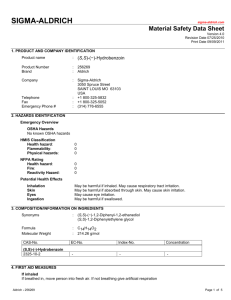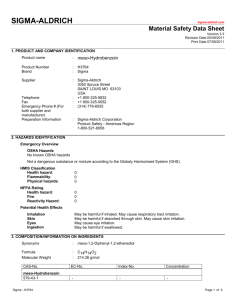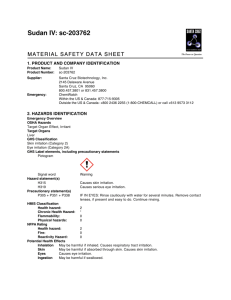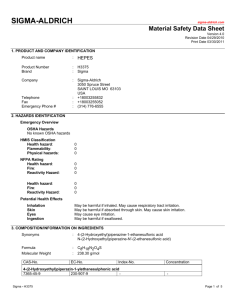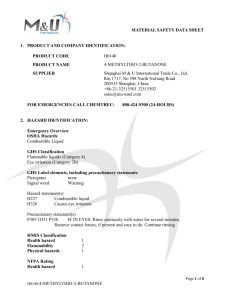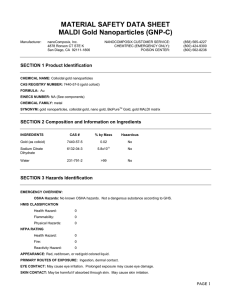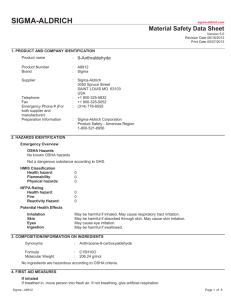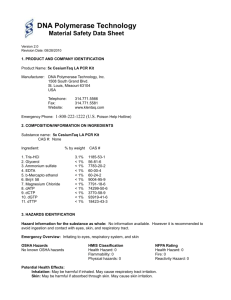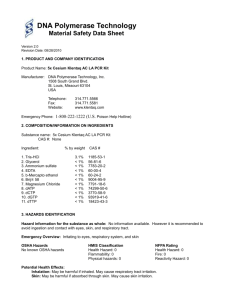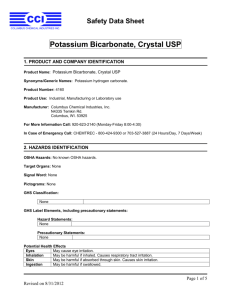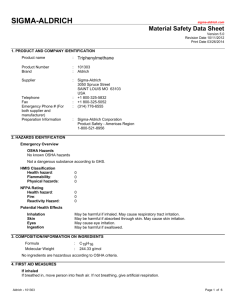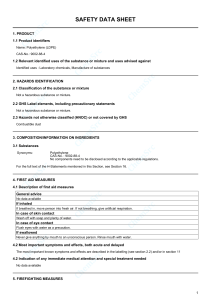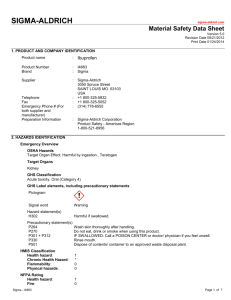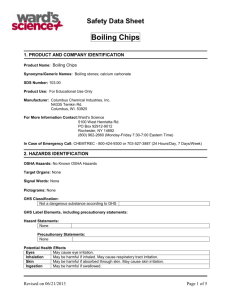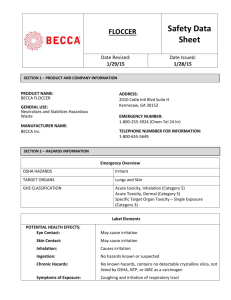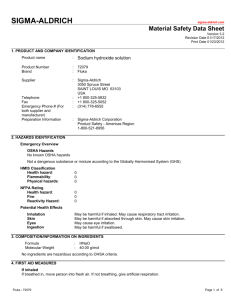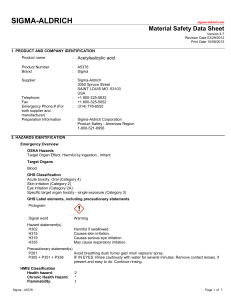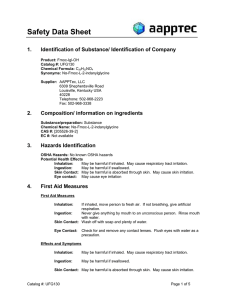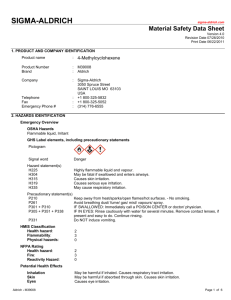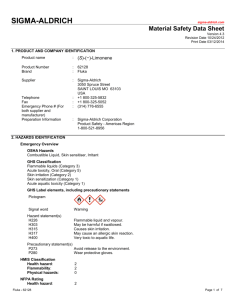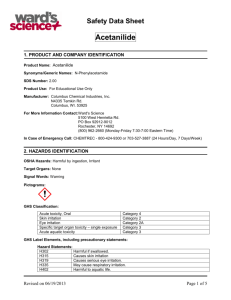Agatoxin and anti-Agatoxin Dot Blot
advertisement
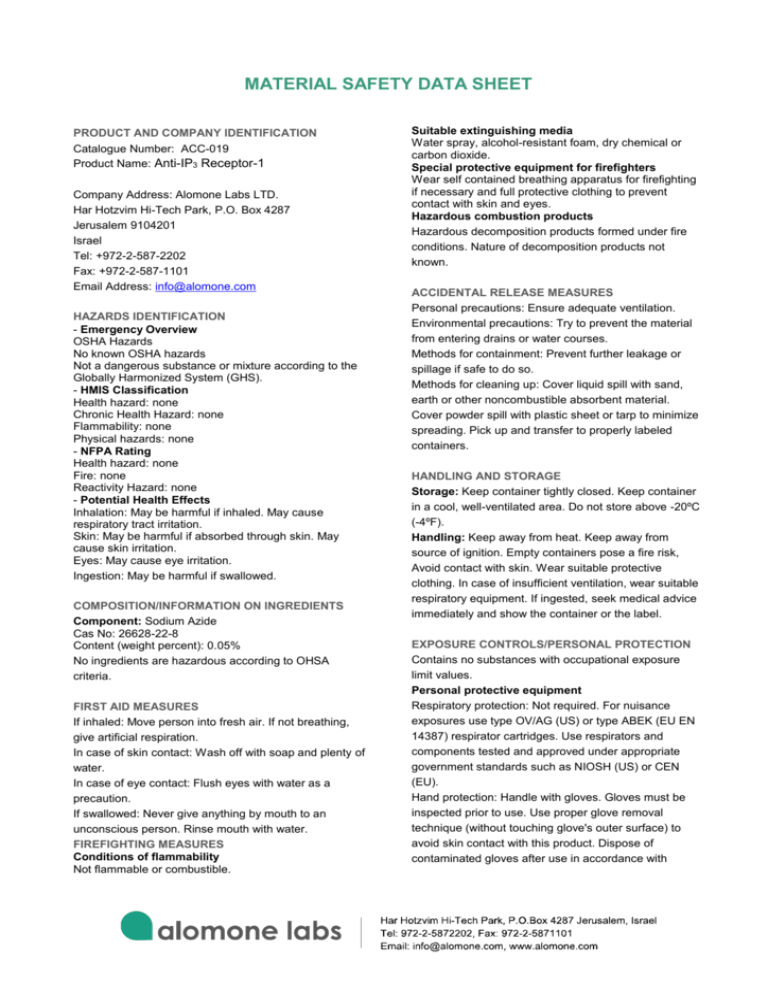
MATERIAL SAFETY DATA SHEET PRODUCT AND COMPANY IDENTIFICATION Catalogue Number: ACC-019 Product Name: Anti-IP3 Receptor-1 Company Address: Alomone Labs LTD. Har Hotzvim Hi-Tech Park, P.O. Box 4287 Jerusalem 9104201 Israel Tel: +972-2-587-2202 Fax: +972-2-587-1101 Email Address: info@alomone.com HAZARDS IDENTIFICATION - Emergency Overview OSHA Hazards No known OSHA hazards Not a dangerous substance or mixture according to the Globally Harmonized System (GHS). - HMIS Classification Health hazard: none Chronic Health Hazard: none Flammability: none Physical hazards: none - NFPA Rating Health hazard: none Fire: none Reactivity Hazard: none - Potential Health Effects Inhalation: May be harmful if inhaled. May cause respiratory tract irritation. Skin: May be harmful if absorbed through skin. May cause skin irritation. Eyes: May cause eye irritation. Ingestion: May be harmful if swallowed. COMPOSITION/INFORMATION ON INGREDIENTS Component: Sodium Azide Cas No: 26628-22-8 Content (weight percent): 0.05% No ingredients are hazardous according to OHSA criteria. FIRST AID MEASURES If inhaled: Move person into fresh air. If not breathing, give artificial respiration. In case of skin contact: Wash off with soap and plenty of water. In case of eye contact: Flush eyes with water as a precaution. If swallowed: Never give anything by mouth to an unconscious person. Rinse mouth with water. FIREFIGHTING MEASURES Conditions of flammability Not flammable or combustible. Suitable extinguishing media Water spray, alcohol-resistant foam, dry chemical or carbon dioxide. Special protective equipment for firefighters Wear self contained breathing apparatus for firefighting if necessary and full protective clothing to prevent contact with skin and eyes. Hazardous combustion products Hazardous decomposition products formed under fire conditions. Nature of decomposition products not known. ACCIDENTAL RELEASE MEASURES Personal precautions: Ensure adequate ventilation. Environmental precautions: Try to prevent the material from entering drains or water courses. Methods for containment: Prevent further leakage or spillage if safe to do so. Methods for cleaning up: Cover liquid spill with sand, earth or other noncombustible absorbent material. Cover powder spill with plastic sheet or tarp to minimize spreading. Pick up and transfer to properly labeled containers. HANDLING AND STORAGE Storage: Keep container tightly closed. Keep container in a cool, well-ventilated area. Do not store above -20ºC (-4ºF). Handling: Keep away from heat. Keep away from source of ignition. Empty containers pose a fire risk, Avoid contact with skin. Wear suitable protective clothing. In case of insufficient ventilation, wear suitable respiratory equipment. If ingested, seek medical advice immediately and show the container or the label. EXPOSURE CONTROLS/PERSONAL PROTECTION Contains no substances with occupational exposure limit values. Personal protective equipment Respiratory protection: Not required. For nuisance exposures use type OV/AG (US) or type ABEK (EU EN 14387) respirator cartridges. Use respirators and components tested and approved under appropriate government standards such as NIOSH (US) or CEN (EU). Hand protection: Handle with gloves. Gloves must be inspected prior to use. Use proper glove removal technique (without touching glove's outer surface) to avoid skin contact with this product. Dispose of contaminated gloves after use in accordance with applicable laws and good laboratory practices. Wash and dry hands. Eye protection: Use equipment for eye protection tested and approved under appropriate government standards such as NIOSH (US) or EN 166(EU). Skin and body protection: Impervious clothing. The type of protective equipment must be selected according to the concentration and amount of the dangerous substance at the specific workplace. Hygiene measures: General industrial hygiene practice. PHYSICAL AND CHEMICAL PROPERITES Appearance Form: Solid Colour: White powder Safety data pH: No data available Melting point/freezing point: No data available Boiling point: No data available Flash point: No data available Ignition temperature: No data available Auto-ignition temperature: No data available Lower explosion limit: No data available Upper explosion limit: No data available Vapor pressure: No data available Density: No data available Water solubility: No data available Partition coefficient n-octanol/water: No data available Relative vapor density: No data available Odour: No data available Odour Threshold: No data available Evaporation rate: No data available STABILITY AND REACTIVITY Stability: Stable under normal handling conditions. Conditions to Avoid: N/A Hazardous Combustion or Decomposition Products: May emit toxic gases such as carbon dioxide, carbon monoxide and nitrogen oxides upon thermal decomposition. TOXICOLOGICAL INFORMATION Acute toxicity Oral LD50: No data available Inhalation LC50: No data available Dermal LD50: No data available Other information on acute toxicity: No data available Skin corrosion/irritation: No data available Serious eye damage/eye irritation: No data available Respiratory or skin sensitization: No data available Germ cell mutagenicity: No data available Carcinogenicity IARC: No component of this product present at levels greater than or equal to 0.1% is identified as probable, possible or confirmed human carcinogen by IARC. ACGIH: No component of this product present at levels greater than or equal to 0.1% is identified as a carcinogen or potential carcinogen by ACGIH. NTP: No component of this product present at levels greater than or equal to 0.1% is identified as a known or anticipated carcinogen by NTP. OSHA: No component of this product present at levels greater than or equal to 0.1% is identified as a carcinogen or potential carcinogen by OSHA. Reproductive toxicity: No data available Teratogenicity: No data available Specific target organ toxicity - single exposure (Globally Harmonized System): No data available Specific target organ toxicity - repeated exposure (Globally Harmonized System): No data available Aspiration hazard: No data available Potential health effects Inhalation: May be harmful if inhaled. May cause respiratory tract irritation. Ingestion: May be harmful if swallowed. Skin: May be harmful if absorbed through skin. May cause skin irritation. Eyes: May cause eye irritation. Signs and Symptoms of Exposure To the best of our knowledge, the chemical, physical, and toxicological properties have not been thoroughly investigated. Synergistic effects: No data available Additional Information RTECS: Not available ECOLOGICAL INFORMATION Toxicity: no data available Persistence and degradability: No data available Bioaccumulative potential: No data available Mobility in soil: No data available PBT and vPvB assessment: No data available Other adverse effects: No data available DISPOSAL CONDITIONS Methods of disposal: Waste must be disposed of in accordance with federal, state and local environmental control regulations. TRANSPORT INFORMATION DOT (US): Not dangerous goods IMDG: Not dangerous goods IATA: Not dangerous goods REGULATORY INFORMATION OSHA Hazards: No known OSHA hazards SARA 302 Components: The following components are subject to reporting levels established by SARA Title III, Section 302: Sodium azide CAS-No. 26628-22-8 SARA 313 Components: This material does not contain any chemical components with known CAS numbers that exceed the threshold (De Minimis) reporting levels established by SARA Title III, Section 313. SARA 311/312 Hazards: No SARA Hazards Massachusetts Right to Know Components: Sodium azide CAS-No. 26628-22-8. Pennsylvania Right to Know Components: Water CASNo. 7732-18-5. Disodium hydrogenorthophosphate 7558-79-4. Sodium azide 26628-22-8. New Jersey Right to Know Components: Water CASNo. 7732-18-5. California Prop. 65 Components: This product does not contain any chemicals known to State of California to cause cancer, birth defects, or any other reproductive harm.WHMIS Note: This product has been classified in accordance with the hazard criteria of the Controlled Products Regulations (CPR) and the MSDS contains all the information required by the CPR. OTHER INFORMATION The above information is believed to be correct, but does not purport to be all inclusive and should be used as a guide only for experienced personnel. Always consult your safety advisor and follow local and national safety legislation. The absence of warning may not, under any circumstances, be taken to mean that no hazard exists. DATE: June, 2013
